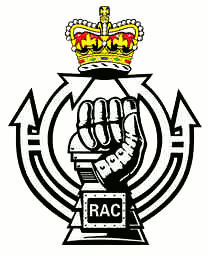 W
WThis is a list of regiments within the British Army's Royal Armoured Corps during World War II.
 W
WThe 144th Regiment Royal Armoured Corps was an armoured regiment of the British Army. Originally raised during World War II as a battalion of the East Lancashire Regiment it was later transferred to the Royal Armoured Corps. It fought in the campaign in North-West Europe, from June 1944 to May 1945.
 W
WThe 145th Regiment Royal Armoured Corps was an armoured regiment of the British Army's Royal Armoured Corps that served in North Africa, Tunisia and Italy during World War II.
 W
WThe 146th Regiment Royal Armoured Corps was an armoured regiment of the British Army's Royal Armoured Corps that served in India, Burma, and Sumatra during and after World War II. 146 RAC survived the war, and was still active in early 1947.
 W
WThe 148th Regiment Royal Armoured Corps was an armoured regiment of the British Army's Royal Armoured Corps during World War II. It fought in the invasion of Normandy in 1944.
 W
W158th Regiment Royal Armoured Corps was a short-lived armoured regiment of the British Army's Royal Armoured Corps serving in India during World War II.
 W
W159th Regiment Royal Armoured Corps was a short-lived armoured regiment of the British Army's Royal Armoured Corps serving in India during World War II.
 W
W160th Regiment Royal Armoured Corps was a short-lived armoured regiment of the British Army's Royal Armoured Corps serving in India during World War II.
 W
WThe 163rd Regiment Royal Armoured Corps was a short-lived armoured regiment of the British Army's Royal Armoured Corps that served in India during World War II.
 W
WThe Westminster Dragoons (WDs) was a yeomanry regiment of the British Army Army Reserve, located in central London. Its lineage is continued by one of the Royal Yeomanry's six squadrons. Formed in the aftermath of Second Boer War as part of the County of London Yeomanry, the WDs fought in the Battle of Gallipoli and led British forces onto the beaches during the Normandy Invasion in 1944. The squadron most recently saw action on Operation Telic, for which it was mobilised for the 2003 war in Iraq.
 W
WThe 1st King's Dragoon Guards was a cavalry regiment in the British Army. The regiment was raised by Sir John Lanier in 1685 as the 2nd Queen's Regiment of Horse, named in honour of Queen Mary, consort of King James II. It was renamed the 2nd King's Own Regiment of Horse in 1714 in honour of George I. The regiment attained the title 1st King's Dragoon Guards in 1751. The regiment served as horse cavalry until 1937 when it was mechanised with light tanks. The regiment became part of the Royal Armoured Corps in 1939. After service in the First World War and the Second World War, the regiment amalgamated with the 2nd Dragoon Guards in 1959 to form the 1st The Queen's Dragoon Guards.
 W
WThe 2nd Dragoon Guards was a cavalry regiment of the British Army. It was first raised in 1685 by the Earl of Peterborough as the Earl of Peterborough's Regiment of Horse by merging four existing troops of horse.
 W
WThe North Somerset Yeomanry was a part-time cavalry regiment of the British Army from 1798 to 1967. It maintained order in Somerset in the days before organised police forces, and supplied volunteers to fight in the Second Boer War. It served on the Western Front in the First World War. At the outbreak of the Second World War, it continued to operate in the mounted role and then as a specialist signals unit. Postwar it joined the Royal Armoured Corps and later became infantry. Its lineage today is maintained by 93 Squadron 39 (Skinners) Signal Regiment.